Augmented Reality (AR) Trends and Developments
Augmented reality (AR) is a technology that overlays digital information onto the real world, creating an immersive experience for the user. With the increasing popularity of AR, many industries are exploring its potential to revolutionize the way we interact with the world around us.
One of the biggest trends in AR is the integration of artificial intelligence (AI) and machine learning (ML). These technologies allow for more personalized experiences for users, as they can adapt to individual preferences and behavior. For example, a shopping app that uses AR to let users try on clothes virtually could also use AI to recommend clothing based on their body type and style preferences.
Another trend in AR is the integration of 5G technology. 5G allows for faster and more reliable internet connections, which is essential for delivering high-quality AR experiences. As more people have access to 5G networks, we can expect to see even more advanced AR applications.
AR is also becoming more accessible to developers, thanks to the development of new tools and platforms. Unity, for example, is a popular game engine that has been adapted for AR development. It allows developers to create immersive experiences without needing extensive knowledge of AR programming. This opens up the potential for more people to create AR applications and brings down the cost of development.
One area where AR is having a significant impact is in the field of education. AR can be used to create interactive lessons that bring the subject matter to life, allowing students to explore concepts in a more engaging way. For example, an anatomy class could use AR to let students explore the human body in 3D, allowing them to see how different systems and organs interact with each other.
AR is also being used in the fields of marketing and advertising. Brands are using AR to create interactive experiences that allow customers to engage with their products in a more meaningful way. For example, IKEA’s AR app lets customers visualize how furniture would look in their home before making a purchase. This not only helps customers make better decisions, but also increases brand loyalty and sales.
Another area where AR is having a significant impact is in the field of healthcare. AR can be used to assist surgeons during procedures, allowing them to see important information overlaid onto the patient’s body. For example, a surgeon could use AR to see the location of key blood vessels during a heart surgery, reducing the risk of complications.
However, with all these advancements in AR, there are also concerns about privacy and security. As AR technology becomes more integrated into our daily lives, we need to be aware of how our data is being collected and used. Developers must prioritize user privacy and ensure that their applications are secure.
In conclusion, augmented reality is a rapidly evolving technology with countless potential applications. The integration of AI and ML, 5G technology, and the development of new tools and platforms are just some of the trends and developments shaping the future of AR. From education to marketing and healthcare, AR has the potential to revolutionize the way we interact with the world around us. However, as with any new technology, there are concerns about privacy and security that must be addressed. As mixed reality development continues to grow, it will be interesting to see how these trends and developments shape the future of this exciting technology.
FAQs:
1. What is augmented reality?
Augmented reality is a technology that overlays digital information onto the real world, creating an immersive experience for the user.
2. What are some of the trends and developments in AR?
Some of the trends and developments in AR include the integration of artificial intelligence and machine learning, 5G technology, and the development of new tools and platforms.
3. How is AR being used in education?
AR can be used to create interactive lessons that bring the subject matter to life, allowing students to explore concepts in a more engaging way.
4. How is AR being used in marketing and advertising?

Brands are using AR to create interactive experiences that allow customers to engage with their products in a more meaningful way.
5. How is AR being used in healthcare?
AR can be used to assist surgeons during procedures, allowing them to see important information overlaid onto the patient’s body.
6. What are some concerns about privacy and security in AR?
There are concerns about how user data is being collected and used as AR technology becomes more integrated into our daily lives. Developers must prioritize user privacy and ensure that their applications are secure.


